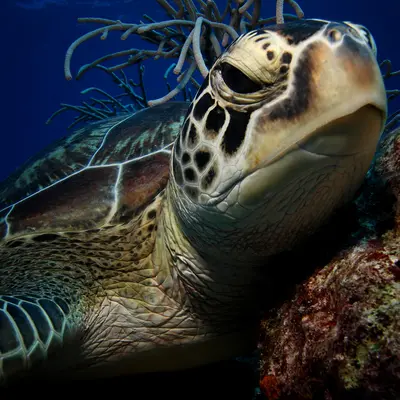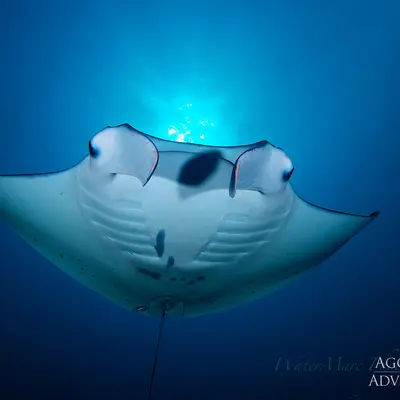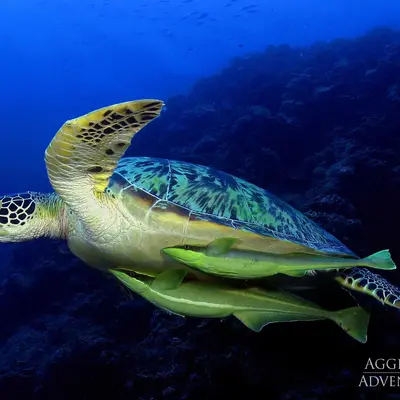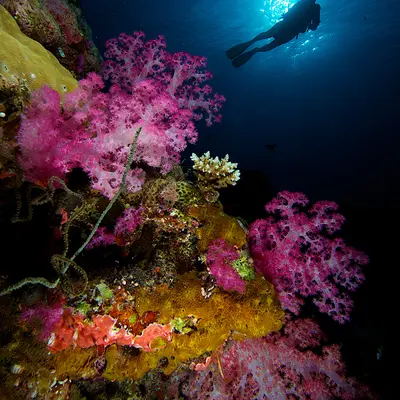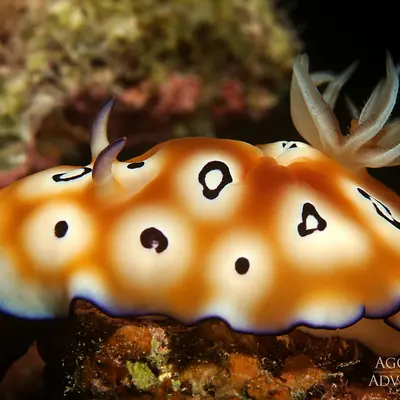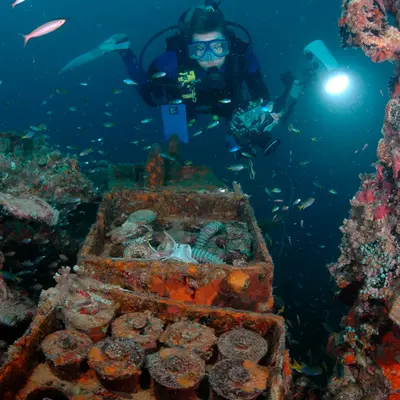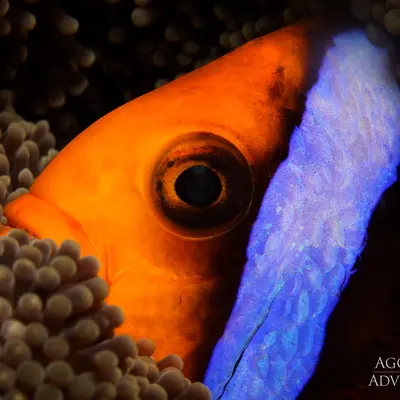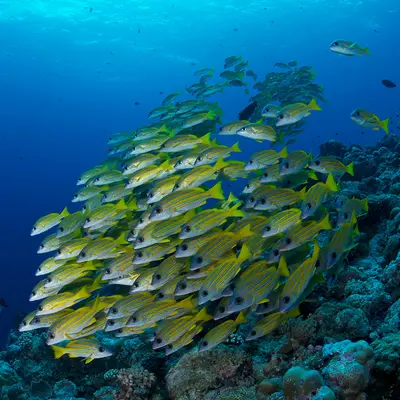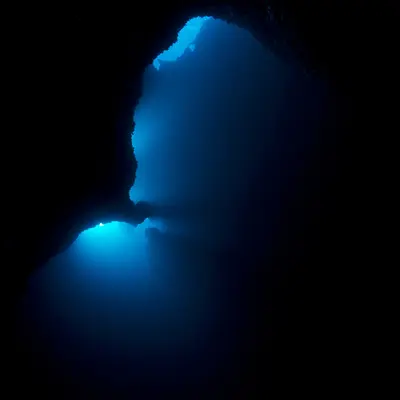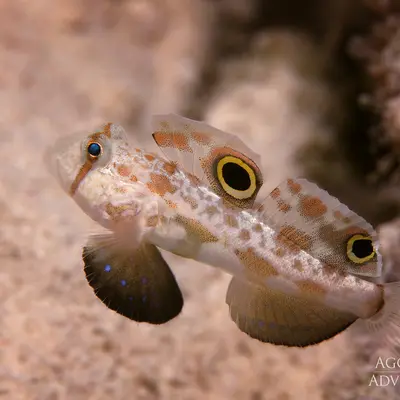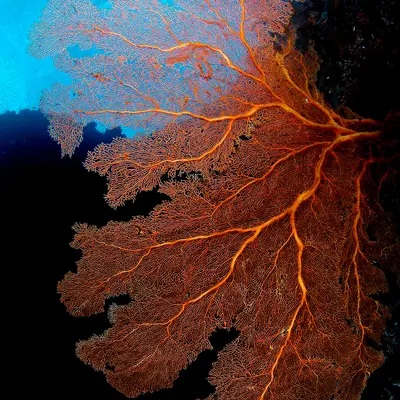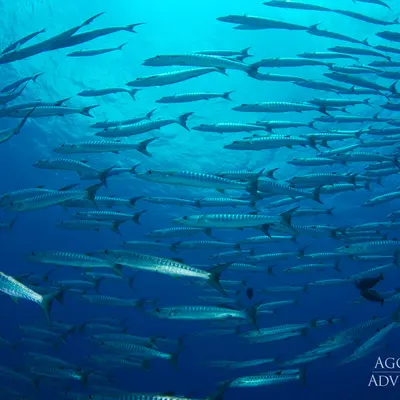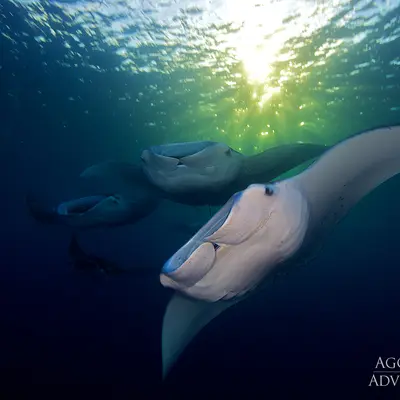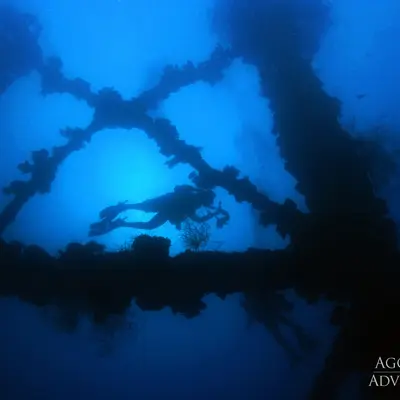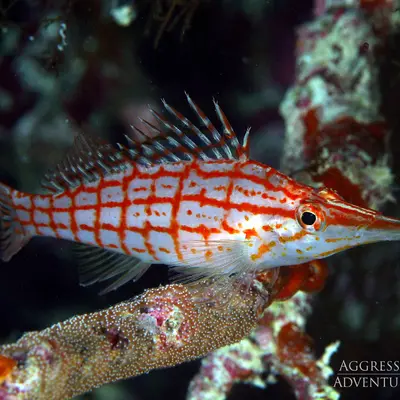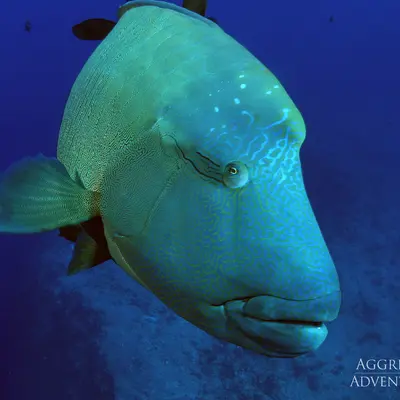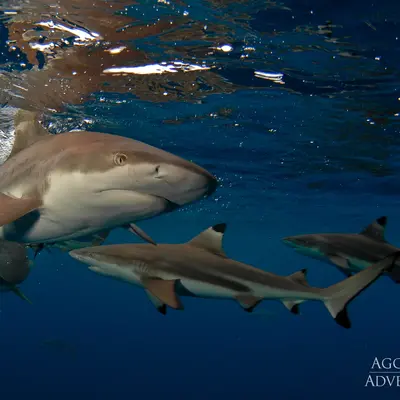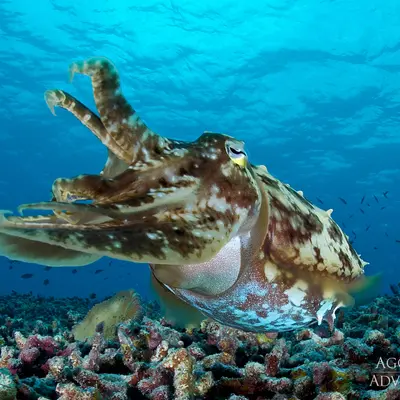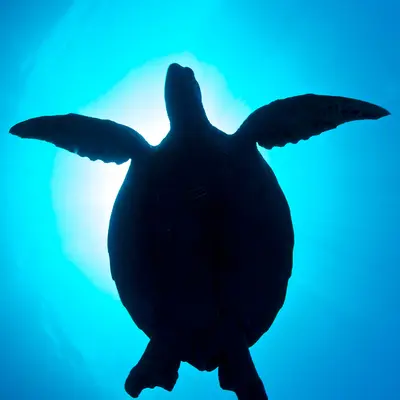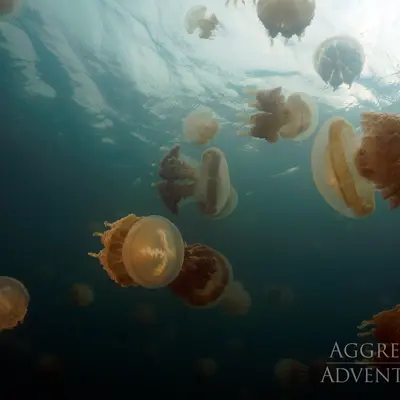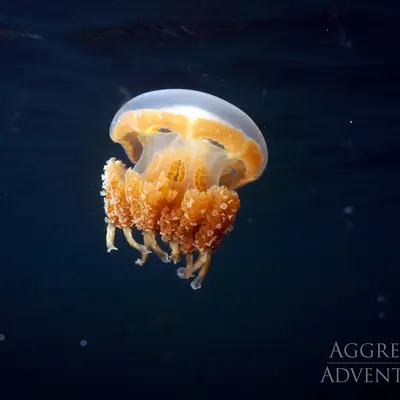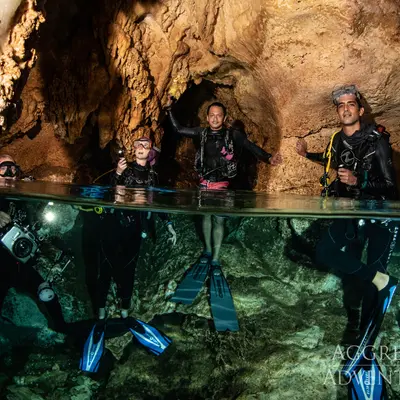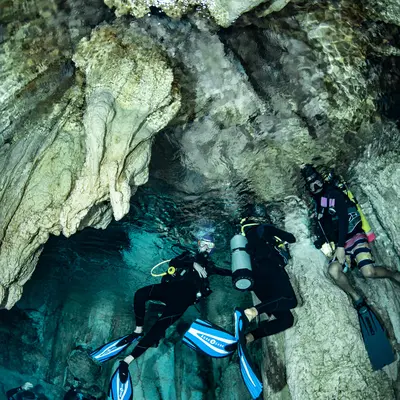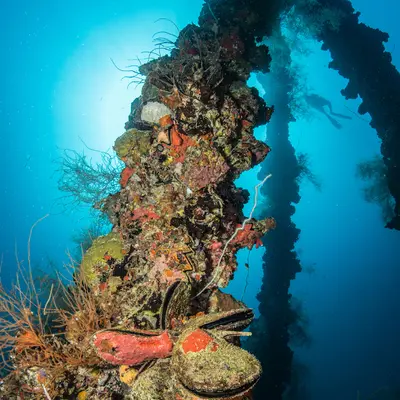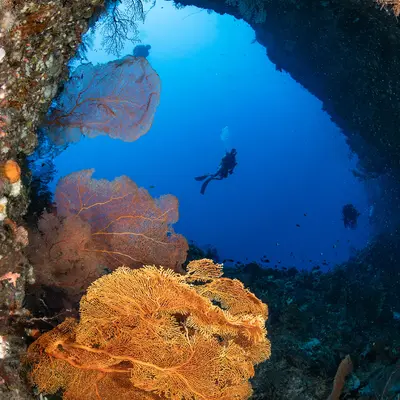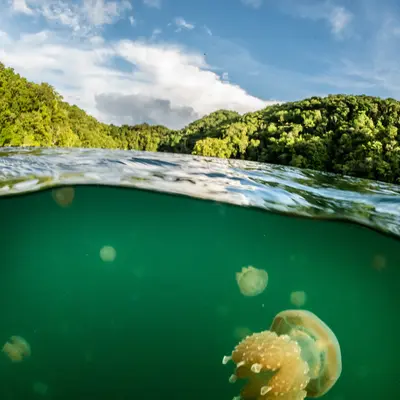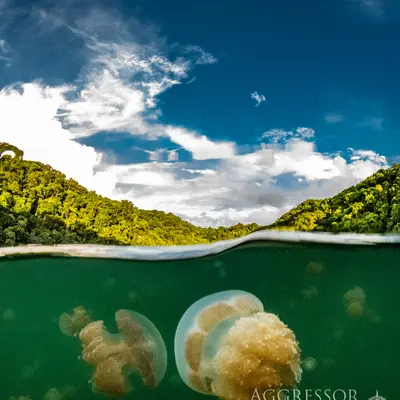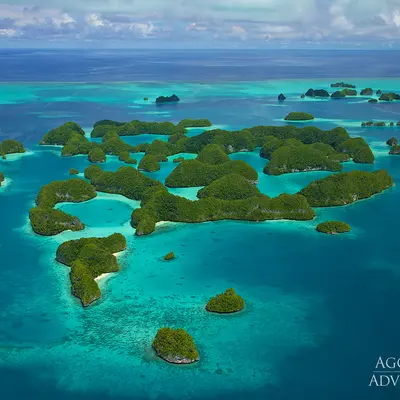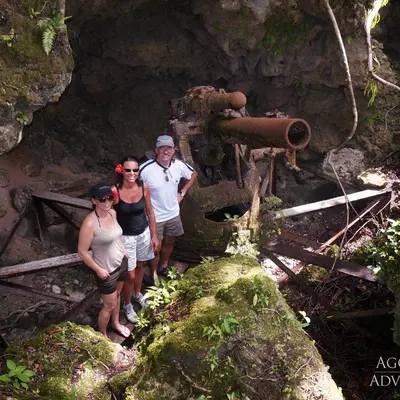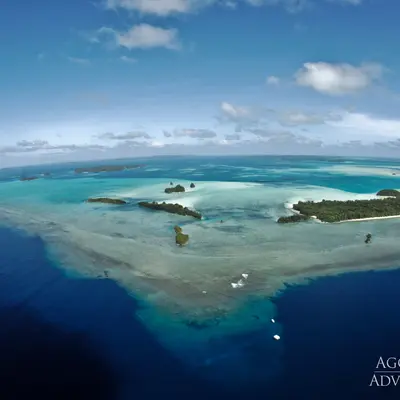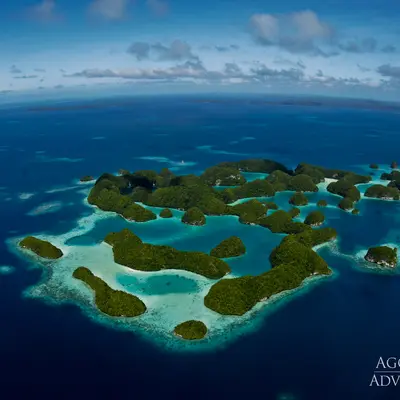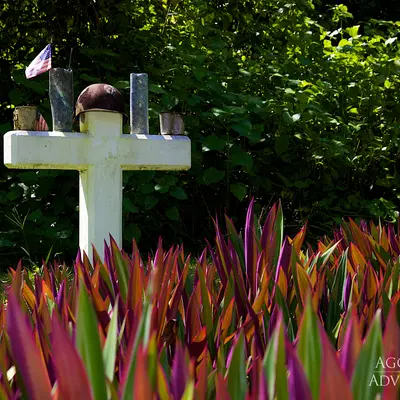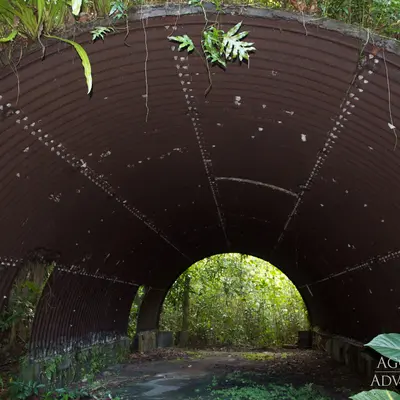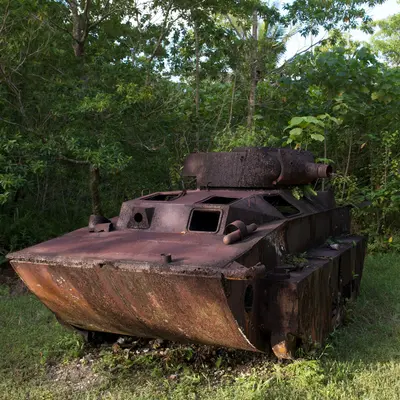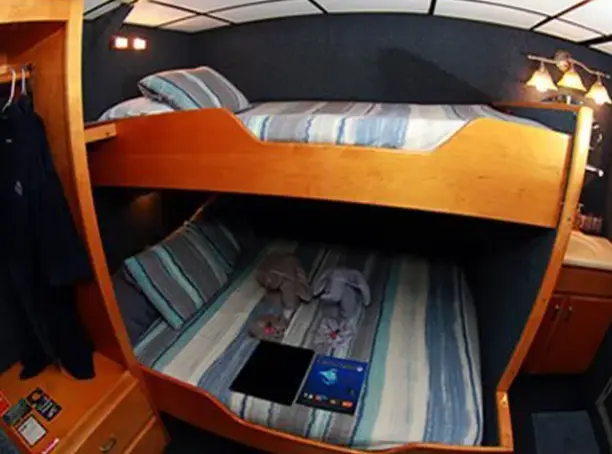The attentive crew of six ensures the well-being and satisfaction of the guests. The MV Palau Aggressor II has nine comfortable cabins with en-suite bathrooms, wardrobes and air conditioning, so that a maximum of 18 guests can be accommodated on board. Guests are spoilt with a varied mix of international and local cuisine.
Soft drinks, iced tea, beer and wine are also available. The air-conditioned lounge invites guests to relax, while the sun deck with deckchairs, a bar and a music system provides additional comfort.
This website uses Google Maps to embed map material. Please note that your personal data may be collected in the process. To view the Google Maps map, please agree that it is loaded from the Google server.
The MV Palau Aggressor II is a 32 metre long luxury liveaboard that offers diving tours in the waters of Palau all year round. On board, divers have the opportunity to explore impressive wrecks from the Second World War, spectacular steep walls and fascinating "blue holes".
Up to five exciting dives a day and a weekly night dive are on the programme. All dives take place from a spacious and well-equipped dinghy.
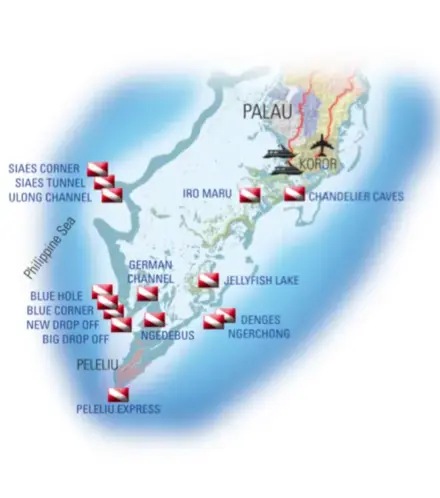
Palau
is a year-round destination that has something to offer in every season. While the English Channel is home to many manta rays, guests can see up to 20 to 30 rays during the mating season from December to March! In February and March, there are large schools of Moorish idols, unicorn fish and various species of butterfly fish. Throughout the year, the boat crew encounters huge bait balls of scad in and around Ulong and German Channel as well as on the reefs of Blue Corner and Siaes Corner.
The Palau Aggressor II and the Rock Islands Aggressor have now brought guests to Jellyfish Lake again. We will try to get there every week, weather permitting.
Sample itinerary:
Day 1: Guests arriving at Koror International Airport (ROR) on Sunday evening will be greeted by a uniformed crew member or a Neco tourism agent. There are no telephones or taxis at the small airport, so we can assist you with the transfer to the yacht. If you are already on the island, you can board at 16.30 on Sunday. Guests can board until Monday morning, the boat leaves the jetty at 6am. The boat is moored in front of the harbour of Neco Marine (Malakai) in Palau.
Day 2 - 7: Eat, sleep and dive in the amazing sites of Palau! After days of diving, the boat returns to the dock on Saturday afternoon after lunch.
Day 8: Check-out is at 8am on Sunday morning. The crew will be happy to help you organise transport to the airport or a local hotel if you are extending your stay.
Top dive sites - Palau:
Big Drop-Off: A wall dive that starts as shallow as 2' at low tide and drops to 600'. It is considered by most to be the most beautiful wall dive in Palau as it offers an abundance of hard and soft corals, sea fans, schools of pyramid butterflyfish and a variety of tropical reef fish.
Blue Corner: The best known and best rated dive site in Micronesia has a shallow coral shelf that juts out into the ocean with vertical walls on both sides. An upwelling created by the current attracts schools of fish and large pelagic animals to the upper edges of the walls. The dive is best known for its schools of grey reef sharks that cruise along the edge of the wall. Two resident Napoleon wrasse often accompany divers during their dive. Dogtooth tuna, eagle rays, manta rays, white tip and hammerhead sharks, turtles, schools of barracudas and shoals of reef fish populate the site.
Blue holes: This is a series of four large holes in the top of the reef that converge to form a gigantic underwater chamber. The chamber has a huge opening on one wall where soft corals, sea fans, sea whips and hard corals live. The large pelagic animals that are frequently encountered here include tuna, mackerel, grey and whitetip reef sharks, barracudas and eagle rays. Groupers, Napoleon wrasse, triggerfish, Moorish idols, butterflyfish, anemones and turtles are common at this site, which is located next to Blue Corner.
Chandelier Caves: A short swim through a tunnel at a depth of 35 feet opens into a cave consisting of three chambers. Beautiful stalactites, formed by water dripping through the rock island above, hang from the ceiling and give the caves their name. Tiny holes to the outside world allow fresh air to enter the chambers so that divers can surface and admire the beautiful surroundings.
Denges Passage: This natural channel on the east coast of Palau is home to a whole family of cuttlefish. The unusual creatures, related to the octopus family, are as accommodating to photographers as they are rare. They are not often encountered by divers as they find relatively few places in the world, can remain relatively motionless and have excellent camouflage.
German Channel: This man-made channel through the south-west side of the barrier reef is home to two dive sites. One site, known as Manta Rock, is a natural cleaning station where giant manta rays have their bodies cleaned of parasites and debris by cleaner wrasse. Grey reef sharks also often make use of the wrasse's services. The area is also inhabited by barracudas, snappers, titan triggerfish, gobies, lionfish, leaf fish and an octopus. Nearby is a coral garden with crocodile fish, nudibranchs, flatworms, anemones and clownfish.
New Drop-Off: Halfway between Blue Corner and Big Drop-Off, this vertical wall is similar to Blue Corner in that it is a shallow shelf that juts out into the ocean, catching the current and creating an upwelling that attracts schools of pyramid butterflyfish and barracuda, as well as a number of grey reef sharks. The wall is covered with soft corals and sea fans
Ngedebus Coral Gardens: One of the best collections of stony corals in the Pacific, this dive has a spur and groove reef structure that harbours turtles, octopus, anemones, tridacna clams, white tip reef sharks and thousands of small schooling fish.
Ngerchong: Ngerchong Island, just beyond Denges Passage, has two dive sites nearby: Ngerchong Outside and Ngerchong Coral Gardens. Ngerchong Outside is a sloping wall dive with sea fans, anemones, soft corals and many hard coral formations. Sharks, bumphead parrotfish and schooling fish are often seen here, as well as the occasional manta ray. The Coral Gardens, also known as Ngerchong Inside, is probably the best dive in Palau to see an abundance and variety of hard corals. Table corals, staghorn corals, elkhorn corals, mushroom corals and brain corals are just some of the coral species that can be found here. Many anemones with clownfish also thrive here, as well as octopus, turtles and other fish. This dive can be enjoyed at any depth between 10' and 80'.
Peleliu: The island of Peleliu, at the southern tip of the main archipelago of Palau, is bordered by magnificent walls. Dive sites include Peleliu Corner, Yellow Wall and Orange Beach. The dive sites of Peleliu are mainly steep walls covered with sea fans, sea whips, stony corals and anemones, but dominated by soft corals. Peleliu is an excellent place to observe large pelagic creatures, especially sharks.
Short Drop-Off: A sloping wall directly in front of the entrance to Koror harbour, covered with huge sea fans. At the top of the wall is a beautiful coral garden with tropical fish and invertebrates.
Siaes tunnel: An exceptional deep dive on the west side of Palau, near the Ulong Channel. The dive begins on a steep wall with the tunnel opening at 70 feet. You enter through an opening that is about 50 feet wide and 20 feet high and swim through the tunnel that runs 150 feet parallel to the wall. The inside of the tunnel is a large cavern with a ceiling of 80-90' and a floor of 120-130'. Halfway through the tunnel is a \"window\" in the wall that looks out onto the deep blue. You exit through a large opening in the wall at 80'. Stingrays, turtles, schools of mackerel and sharks can be seen in and around the tunnel.
Ulong Channel: This channel is located on the west side of Palau, near the Siaes tunnel and wall. The entrance is surrounded by walls crowned by beautiful coral gardens. When the tide comes in, the mouth of the channel fills with grey reef sharks. The channel stretches for about half a mile and has an average width of 100 feet. The maximum depth is about 60'. Coral-covered walls extend the entire length of the channel on both sides. A shallow ridge running down the centre of the channel is covered with soft corals, hard corals, sea fans and anemones. Unique to this site is a huge patch of plate coral that resembles lettuce leaves and harbours schools of squirrel fish, soldier fish and glass eyes. The current provides a gentle push, making for a nice, leisurely ride along the channel.
Miracle Channel: Located within the rock islands, not far from Jellyfish Lake and Clam City, this channel is best dived on the east side along a wall that starts at the surface and reaches a depth of 80 feet. Soft corals, sea fans, anemones, blue and red starfish, a crown of thorns, starfish, crabs, pipefish and a wide variety of sea slugs, flatworms and nudibranchs can be found along this wall.
Wreck of the Iro Maru: A 145-foot-long merchant ship that was sunk by American bombers during the Second World War. Three mast and gun turrets at the bow and stern harbour a variety of invertebrates and stony corals. The main deck is at a depth of 80 feet with open holds containing oil drums and machinery.
Diving details:
- Known for grey reef sharks, white tip sharks, manta rays, octopus, mandarin fish and WWII wrecks.
- All dives are conducted from a large 35-foot dinghy.
Water temperature:
- 80 - 82F / 27 - 28C
- 3mm wetsuit recommended
Diver:
- The dive boat is 35 feet long and accommodates 18 divers.
- 4 - 5 dives per day are conducted from the dinghy.
- During the week 2 shore excursions are offered to Peleliu Tour and Ulong Beach.
Sample routes and maps are for illustrative purposes only. The exact route and sites visited are subject to change depending on local regulations, guest experience, weather and logistics and are at the captain's discretion.
Guests arriving at Koror International Airport (ROR) on Sunday evening will be greeted by a staff member in uniform or a Neco Tourist Agent and transferred to Palau Aggressor II or Rock Islands Aggressor. There are no telephones or taxis at the small airport, so reservations must be made in advance.
1st Badrulchau stone monolithsThe mysterious Badrulchau stone monoliths are located on the island of Babeldaob - a collection of over 30 basalt stones that were probably erected around 100 AD. Their exact origin and meaning are still unclear, which makes them particularly fascinating.
2nd Ngardmau WaterfallAlso located on Babeldaob, the Ngardmau Waterfall is the highest waterfall in Micronesia. A hike through the tropical rainforest takes you to this impressive natural spectacle, which invites you to take a refreshing dip.
3 Etpison MuseumIn Koror, the Etpison Museum offers a deep insight into the history and culture of Palau. Exhibitions include traditional artworks, historical photographs and artefacts documenting the island nation's rich past.
4 Belau National MuseumAs the oldest museum in Micronesia, the Belau National Museum in Koror presents an extensive collection of cultural and historical artefacts. A traditional bai (meeting house) on the grounds illustrates Palau's architectural tradition.
5 Airai BaiThe Airai Bai is one of the oldest surviving traditional meeting houses in Palau. With its ornate carvings and paintings, it offers an authentic insight into the islands' cultural past.
6. Japanese destroyer wrecksOf particular interest to history buffs are the remains of Japanese destroyers from the Second World War, which can be viewed on land. These relics tell of Palau's strategic importance during the war.
7. bai of AimeliikAnother impressive traditional meeting house is the bai of Aimeliik. Although it is a reconstruction, it gives an authentic impression of Palauan architecture and community culture.
8. hikes on BabeldaobPalau's largest island, Babeldaob, offers numerous hiking trails through unspoilt nature, past rivers, waterfalls and traditional villages. These trails allow visitors to discover the island's diverse flora and fauna.
9. traditional craftsmanshipIn local workshops, such as the Tebang Woodcarving Shop, visitors can experience the art of traditional woodcarving and purchase unique souvenirs. This craftsmanship is an important part of Palauan culture.
10. markets and local cuisineA visit to the local markets in Koror offers the opportunity to sample fresh produce and traditional Palauan dishes. Dishes with fresh fish and seafood are particularly recommended.
These diverse activities and attractions allow visitors to experience the cultural and natural beauty of Palau away from the well-known diving spots
Double cabin lower deck
- 1 double + 1 single bed (floor)
- adjustable air conditioning
- En-suite bathroom
- max. 2 guests
Deluxe double cabin upper deck
- 1 double + 1 single bed (floor)
- adjustable air conditioning
- En-suite bathroom
- max. 2 guests
Included: VAT, alcoholic drinks, soft drinks, tea & coffee, drinking water, wine with dinner, snacks, full board (all meals), dive packages, towels for use on deck, cabin towels, complimentary toiletries.
Required extras: harbour fees (270 USD per trip).
Optional extras: travel insurance, diving insurance, tips, airport transfer (22 USD per trip), hotel transfer (5-22 USD per activity), rental equipment, nitrox, nitrox course, diving courses, additional dives, snorkelling set.
Prices for rental equipment
Rental equipment is available on this ship. Please indicate on the booking form what you need. Details below of what is included and the additional prices.
- 15 litre tanks 75-120 USD per trip
- Regulators 60-90 USD per trip
- BCD 60-90 USD per trip
- Fin 50-75 USD per trip
- Mask 50-75 USD per trip
- Nitrox bottle 100-150 USD per trip
- Snorkel t50-75USD per trip
- Torch 8 USD per day
- Dive computer 60-90 USD per trip
- U/W camera rental 100 USD
- Full equipment (with: regulator, BCD, fins, mask, torch, dive computer) 175-260 USD per trip
- Wetsuit 50-70 USD per trip
- Air temperature: Stable all year round between 26.7 °C and 27.1 °C.
- Water temperature: Constantly warm between 28.2 °C and 28.5 °C, ideal for diving.
- Precipitation: Highest in June (360 mm) and July (347 mm), lowest in March (170 mm).
Palau
is an island nation in the western Pacific and belongs to the Micronesia region. The island state consists of over 300 islands, only a few of which are inhabited. The largest and most important islands are Babeldaob, Koror, Peleliu and Angaur. The capital Ngerulmud is located on the island of Babeldaob, while Koror is the economic and tourist centre of the country. The waters around Palau are famous for their impressive coral reefs, lagoons and limestone islands, which offer breathtaking scenery.
Population and religion:
Palau has a relatively small population of around 18,000 people. Most of the inhabitants are ethnic Palauans, but there is also a significant community of Filipinos, Chinese and other Asian populations. The official languages are Palauan and English, although Japanese also plays a role in some areas.
The predominant religion in Palau is Christianity. About 45% of the population is Roman Catholic, while about 34% is Protestant. There are also smaller communities of Buddhists, followers of indigenous religions and other faiths.
Economic situation:
Palau's economy is mainly based on tourism, fishing and international financial aid, particularly from the USA, with which Palau maintains a "Compact of Free Association". The state imports most consumer goods, as local production is limited. Fishing, primarily the export of tuna, is an important economic sector. Palau is also one of the leading countries in the field of environmental protection and sustainable ecotourism.
Position in the Pacific:
Palau occupies a strategically important position in the western Pacific and is located between the Philippines and Guam. The country is known for its active role in marine conservation. Palau has created one of the largest marine protected areas in the world and is committed to sustainable fishing and environmental protection measures. However, due to its geographical location, it is vulnerable to the effects of climate change, particularly rising sea levels.
Importance of diving tourism:
Palau is one of the best diving destinations in the world and is known for its breathtaking underwater world. The region offers spectacular dive sites with impressive coral reefs, caves, wrecks from the Second World War and an extraordinary variety of marine life. Sites such as Blue Corner, German Channel, Ulong Channel and Jellyfish Lake are world-famous and attract thousands of divers every year.
Diving tourism is crucial to Palau's economy. It is one of the country's largest sources of income and provides many locals with jobs as diving instructors, boat guides, hotel staff and tour operators. The government is strongly in favour of sustainable tourism in order to protect the islands' fragile ecosystem and at the same time derive economic benefits from it.
Palau is not only a tropical paradise with unrivalled natural beauty, but also a pioneer in environmental protection. The protection of the marine environment and the promotion of sustainable diving tourism are central components of the national identity. Visitors to Palau not only experience spectacular nature, but also support the efforts of a small island nation to preserve its unique heritage for future generations.

